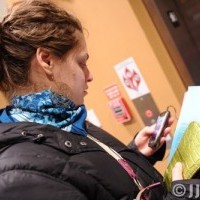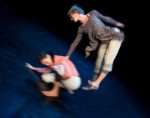
Starting the Commotion
by Amelia Longo
The Commotion festival was a surprising new take on linking community and performance in the Grays Ferry, Point Breeze, and South of South Street neighborhoods of Philadelphia. Developed as a partnership between PECO, The University of the Arts, and the Philadelphia Redevelopment Authority, it utilized the help of students and local community members, and was the first time the PRA’s Percent for Art Program was used for live art, despite being the oldest such program in the country. The festival, which ran from June 16th to 30th, offered free, original, site-specific performances, including “Shiloh Dance Days” with subcircle and Team Sunshine Performance Corporation.In subcircle’s forget me...forget me not, groups of about twenty audience members were guided through back rooms of Shiloh Baptist Church. We first entered a small room with a lace-covered table set for tea and cookies, where Paul Struck and Scott McPheeters meticulously rearranged cups and saucers as they seated some of the guests, drawing their attention to adages on slips of paper at each place setting. McPheeters’ charged glances were a dance all their own.
At a kettle’s whistle, the door opened, and we trickled through a kitchen area where a silhouette danced on the window via Jorge Cousineau’s film installation, and up to the top floor. In a small back room, McPheeters, Christy Lee, and Niki Cousineau swung from shower stalls and circled around one another, their shoes pleasantly scraping the crumbly concrete floor. By the time they eventually began to touch, their dancing seemed organically synced.
This space was small, so I wandered into a larger room, where tables were laid out with mismatched artifacts: lace up boots, Boy Scout memorabilia, hand-written notes. The dancers entered, the audience followed, and we watched them: brushing off clothes, waving fingers, biting thumbs. The audience waved fans to cool down, in an unexpected addition to the performers’ subtle movements. Next we were led downstairs past Rosie Langabeer, singing and accompanying herself on an out-of-tune piano, and we ended in the kitchen, the piece a bit unresolved.
There we were served a free meal. People mostly sat with those they already knew, but after a bit of instigating, I learned my table included students involved in Commotion’s development, friends of one of the performers, and a local arts director with her family. I talked with Shiloh’s Reverend Sparkman, who emphasized the potential for Shiloh Dance Days to showcase the church’s history, noting that the objects in subcircle’s piece were indeed indigenous artifacts. However, I don’t think the audience, myself included, would have known this without such a conversation.
In Wonderwave, directed by Alex Torra, Team Sunshine Performance Corporation’s Benjamin Camp and Makoto Hirano made clever use of the mundane everyday, like miming a phone conversation, and carefree vernacular dancing. In one section, Hirano moved in slow motion, a video game character entering the different states dictated by Camp’s signs and props. In the first round, he drank coffee, shrugged apologetically to his reprimanding boss, encountered an ex and skulked away. In the following iteration, he encountered a fish and ran off. The fish followed, and Hirano, unable to hit the reset button or wake up this time, was forced to interact. Camp was hilariously deadpan and minimalist as boss, ex, and fish. The contrast between Hirano’s langour and Camp’s unconcerned urgency was fascinating.
After the fish encounter, the two danced together, with Hirano eventually leaping wildly, flapping his arms like fins and kicking his legs out to the side like a tail. Camp grew disinterested and walked off to reconfigure Oona Curley’s fun set, an economical design featuring a mini-fridge that became a rolling cabinet for props, and flexible windows that opened to reveal more props and varying backgrounds.
Team Sunshine Performance Corporation successfully manipulated our emotions nimbly through most of the piece. Though I didn’t see a clear narrative, they pulled me along pleasantly through pop music and familiar tableaus. Towards the end Hirano danced slowly and dramatically (think air punches), and Camp covered him in labels like “Fukushima,” “Powerplant,” and “Senior Citizen.” Without a context or connection, the quick political veneer felt manipulative, of the audience and of the Fukushima disaster. I tried to find a connection in the portion that followed -- something about trying to find a fish, and mistakenly throwing sneakers into a fishbowl -- but even as the search for the fish turned into a search for Hirano, the message remained muddy.
Overall, both pieces were interesting to watch, but their context did them a disservice. Wonderwave was billed as physical theatre, which left me wondering about its inclusion in Shiloh Dance Days and confused about the evening’s focus. I also wondered about Commotion’s intent in regards to space. Forget me...forget me not made ample use of various rooms and artifacts, but this is not the first time the site has hosted an installation (Hidden City Philadelphia brought two installations to the church in 2009). There wasn’t evidence of showcasing the church’s history, encouraging future artistic use, or pointing toward much-needed refurbishing. Wonderwave didn’t seem to connect to the space at all. Further, the pieces seemed oddly paired, and in the end, the shared meal was not enough of a palette cleanser. I felt both pieces would have been better served without the shared bill.
Still, I’m impressed with Commotion’s attempt to expand the Percent for Art Program’s definition of public art, as well as its attempts to redefine an evening of performance for both artists and audiences. I hope to see more in the future, with a clearer mission and closer connection to the communities and spaces involved.
Shiloh Dance Days, Commotion, Shiloh Baptist Church, June 20, 21, 27, & 28.
By Amelia Longo
July 18, 2012








